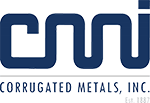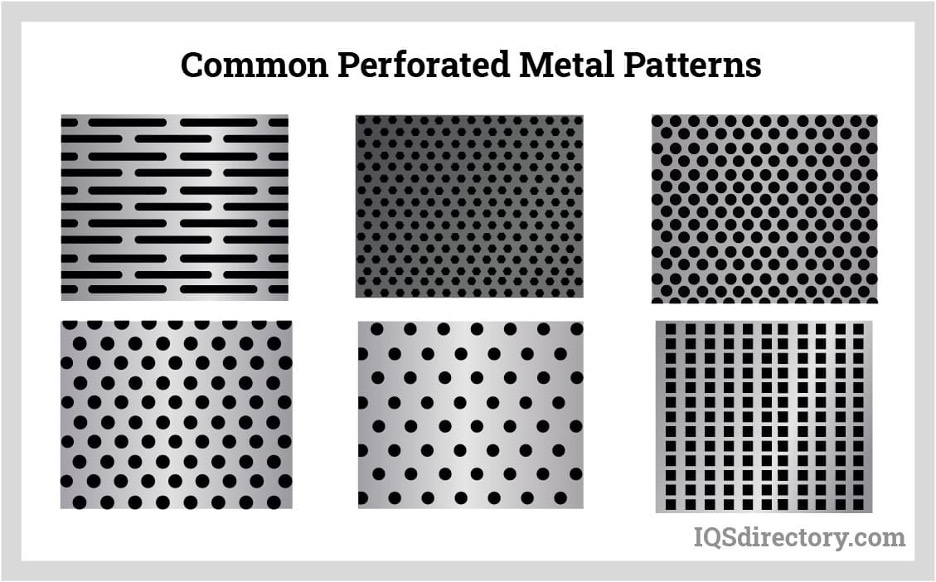Perforated metal offers strength, aesthetics and functionality in one sheet. Moreover, it has been used in construction for over 100 years and has become more popular now than ever before. One reason being – perforated metal is a building material that can fulfill many needs, both decorative and purely practical.
The process of perforating includes pressing or stamping manually on a sheet of metal to form a pattern of holes and slots. And while the material might look simple by its appearance alone, there are many reasons why perforated metals are so popular across all industries.
In this post, we’re walking through the different types, use cases, and benefits of perforated metal that might just make you incorporate the material into your next project.
Perforated Metal Types
The number of metals that can be shaped or machined during the perforation process are limitless. How the metal will be used determines the type of metal that is required for perforation.
For example, strong and durable metals are best used for industrial processes and structural buildings. Lightweight metals on the other hand, better serve in decorative applications. Some common types of materials used in perforation include:
- Stainless Steel – Stainless steel offers many great qualities, including strength, corrosion resistance, and aesthetic appeal. It is thanks to the chromium content within stainless steel that provides advanced corrosion resistance, making it a top-notch perforated sheet option.
- Aluminum – Aluminum is easy to install due to its malleable, durable, and lightweight qualities. Like stainless steel, aluminum also offers an aesthetic appeal that is perfect for applications requiring light and sound diffusion.
- Steel – Products made from steel alloy perforated sheets are best used in commercial and industrial applications without a need for visual aesthetics. Standard steel has similar benefits to stainless and is a lower-cost alternative.
- Galvanized Steel – Since galvanized steel is corrosion-resistant, economical, and exceptionally strong, it is best used in hostile and harsh environments. Galvanized steel possesses a solid zinc coating that eliminates corrosive elements from seeping in, such as moisture, water, and humidity. It combines the strength of steel with its unique endurance for withstanding rugged conditions.
- Copper – The outer surface of copper is corrosion-resistant, portraying a green tint when exposed to the elements. The material is commonly used for both interior design and decorative applications. Perforated copper is visually appealing, can be recycled easily, and has an unlimited life span.
Perforating Methods and Pattern Variety
All perforated metal sheets have a variety of patterns that are designed specifically to serve a unique function depending on how they are used. Patterns for architectural use are ornate, decorative, and aesthetically pleasing, whereas patterns for industrial uses, such as filtration, drainage, and screening, are more conventional and uniform.
Most patterns are unfinished at the end of the sheet to allow for multiple sheets being placed together to form a consistent pattern. Perforated sheets come in a variety of sizes, patterns, and shapes including round staggered, round straight, square, slot, and hex.
Use Cases of Perforated Metal
Perforated metal appears to be a simple product. But in reality, many industries require the material in order to perform specific functions within their operations. Some of the most popular use cases include:
- Transportation – Car, truck, bus and other transportation manufacturers depend on perforated metal to provide strength and durability and improve airflow without adding a substantial amount of weight to their vehicles.
- Architecture – Perforated metal sheets bring functionality and aesthetic value to construction projects. The material adds a unique look to a building while also making it more sustainable. For example, the material is able to absorb the heat given off by the sun without eliminating the daylight inside which helps to lower the use of artificial lighting and AC.
- Food and Beverage – Modern food production requires a lot of processing, and perforated metal can perform many functions in this context such as filtering solids and sifting through particles.
- Noise Control – Since sound waves can travel through perforated metal without changing, noise control systems rely on the material for protection or decorative screens.
- Retail Displays – Due to its lightweight, durable, and versatile qualities, perforated metal often is used for fabricating retail display systems. Perforated metal can be used to create shelves, wall units, and other components for a modular system that can be configured easily to fit a retailer’s space.
Benefits of Perforated Metal
On top of the fact that perforated metal is easy to work with and install, the material also offers many additional benefits that help make applications more sustainable. The biggest advantages of incorporating perforated metal into your project include:
- Aesthetic Appeal – Perforated metal offers a unique, modern aesthetic to compliment any building. With virtually endless options in hole shapes, sizes, geometric patterns and finishes available, perforated metal makes it a perfect material to achieve a specific look. In addition, perforated metal offers a degree of privacy while still allowing occupants to enjoy exterior views.
- Versatility – Part of the versatility of perforated metals is their ability to be bent, shaped, and configured to meet the needs of an application and design. The material serves in both lightweight decorative elements as well as in structural components of buildings.
- Durability – Perforated metal has a structural strength many other materials do not have, allowing it to easily hold up in harsh environments. The perforations also help to lower the weight of the building.
- Energy Efficient – By balancing light and ventilation, perforated metal can allow architects to manage interior heat build-up from the sun. When heat is deflected, HVAC systems put out less energy, helping to keep the interior temperature more consistent. Perforated metal also helps to decrease the amount of light indoors when used as a screening element.
- Eco-Friendly – As the ultimate green material for design and construction, perforated metal minimizes resource depletion due to its recyclability, reduces energy in use, promotes sustainability, invites innovation in terms of design, and lowers fuel transportation costs by reducing the weight of vehicle loads.
Get Started
Perforated metal is a practical alternative for many applications thanks to its combination of strength, functionality, and design flexibility.
Corrugated Metals, Inc. has been an industry-leading resource for perforated metal products for well over a century. From lightweight decorative elements to load-bearing structural components, we design and manufacture perforated metal to meet the precise specifications for the most demanding customers. In addition, we offer numerous choices of hole sizes, shapes, and punch patterns, and our manufacturing capabilities include a vast range of materials in gauges from foil to thick plate.
If you would like more information about our perforated products and how they can benefit your next application, contact us today.


